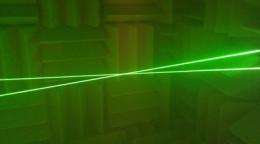A new generation of acoustic measurements

NPL scientists have made the first measurements of airborne acoustic free-field pressures using a laser technique based on photon correlation spectroscopy.
This optical measurement technique directly measures particle velocities and realizes the acoustic pascal - the SI derived unit of pressure - and could potentially be used to calibrate microphones. It is being developed as part of a wider initiative to base future primary acoustic standards on optical methods.
The new technique uses two lasers that are set up so that their beams intersect at a point in space and produce an interference fringe pattern. When sound is produced by a source (such as a loudspeaker), the intensity of light scattered by particles in the air as they pass through the fringe pattern changes. This intensity change can be detected, and the acoustic free-field pressure calculated.
The current method for calibrating microphones relies on their reciprocal nature. Part of the process requires one microphone to be used as a sound source and coupled to a second receiving microphone. This set-up, together with complex modelling of the acoustic coupling between the microphone sensitivities, eventually leads to an evaluation of the microphone sensitivity, which is then traceable to a number of dimensional and electrical quantities.
However, this method imposes limits on the types of microphone which can be calibrated, meaning that non-standard microphones and new technologies such as MEMS (microelectromechanical) sensors cannot be tested and calibrated. Optical techniques are the solution to this problem due to their ability to directly measure the pascal at a point within a sound field.
Research will continue at NPL on developing optical methods that are robust and accurate enough to one day become the primary measurement standards that support sound pressure measurements. The use of optical techniques and the improved calibration they offer may also help to accelerate the development of new microphone technologies and other acoustic devices.
This research was carried out under the National Measurement Office Acoustics and Ionising Radiation Program.
Provided by NPL


















